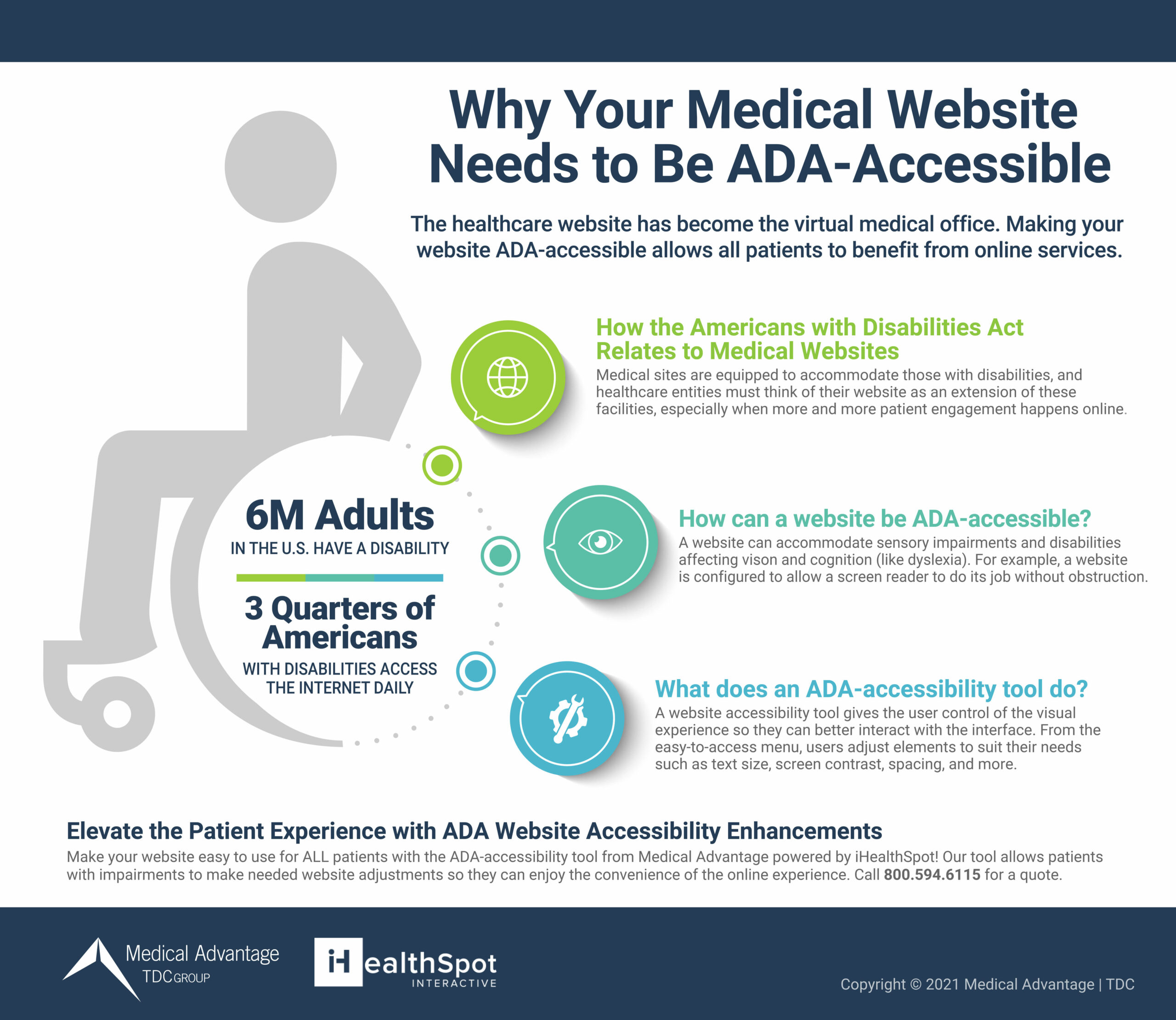What is ADA Compliance for Websites?
Do Websites Have to Be ADA Compliant?
ADA Website Compliance Lawsuits
The Benefits of ADA-Accessible Websites for Healthcare Organizations
Medical Advantage Can Make Your Website More Accessible for the Disabled and Impaired
Over half of disabled Americans have internet access at home. During the shutdowns of 2020, millions of Americans, disabled or not, relied on the internet for their daily needs, driving our society even further toward digital dependence. Bring together these two realities, and a question is raised: can those with disabilities and impairments effectively access the same benefits of a website that abled people enjoy? For this reason, ADA website accessibility is a key factor when building a medical website.
The evolution of the “digital front door” has underscored the integral role that digital assets (like a website) play in the modern patient experience. Patients with disabilities and impairments may not be vocal about usage barriers, but adding ADA accessibility to your website would be a meaningful change for them.
There is a movement to have the web fully accessible by 2025, which, if successful, would further improve the website user experience by way of helpful enhancements. If you have digital front door, patient experience optimization, and inclusivity on the radar lately, ADA website accessibility for your medical practice advances all these initiatives in one swoop.
What is ADA Compliance for Websites?
The Americans with Disabilities Act (ADA) became law in 1990 and declares that citizens with disabilities should have “the same opportunities as everyone else to participate in the mainstream of American life.” Of course, in 1990, the information superhighway we know as the internet did not yet exist.
Over the years, ADA compliance has been about closer parking spaces, wheelchair ramp dimensions, automatic doors, and oversized restroom stalls. But now, as the world has gone digital, many of the things we used to do in person we now do online, and without adequate accommodations for internet use (such as ADA website accessibility), the disabled end up disenfranchised – when the spirit of the ADA was independence and equality.
“With today’s signing of the landmark Americans for Disabilities Act, every man, woman, and child with a disability can now pass through once-closed doors into a bright new era of equality, independence, and freedom…This historic act is the world’s first comprehensive declaration of equality for people with disabilities — the first. Its passage has made the United States the international leader on this human rights issue… It will ensure that people with disabilities are given the basic guarantees for which they have worked so long and so hard: independence, freedom of choice, control of their lives, the opportunity to blend fully and equally into the rich mosaic of the American mainstream.” – President George Bush upon his signing of the ADA
Do Websites Have to Be ADA Compliant?
Because a website is considered an extension of a business, the law seems to imply that websites should be ADA-compliant as well, although the legislation has not yet been updated to include digital assets explicitly. However, some web developers have pointed out that the federal government has not sufficiently defined, in detail, what an ADA-compliant website is.
The WCAG
In response to this gap, the web developer community has built a framework known as the Web Content Accessibility Guidelines (WCAG). This establishes industry-wide website accessibility standards and serves as an ADA website accessibility checklist.
What the ADA Does Provide
The ADA Best Practice Tool Kit for State and Local Governments provides a limited amount of guidance. Here are the main takeaways from this publication geared toward government entities:
- Establish a defined accessibility policy and a plan for how equitable access will be carried out.
- Modify the most used pages and features first.
- Post a notice of your intention online, along with a request for public feedback on what would improve their experience.
- When a webpage is new or modified, make sure it adheres to your accessibility specifications.
- The settings for a user’s device should supersede those of the web design, meaning that when someone visits your site, they will view it with their color and font presets.
- Attach a text equivalent (such as an alt tag) to all photos, graphics, scanned images, or image maps. This should be applied to images already published, and any published in the future.
- For online forms and tables, tag each control (buttons, check boxes, drop-down menus, and text fields) with descriptive HTML.
- If you provide documents on your site, be sure to publish them in a text-based format such as HTML.
- When updating any part of your website, take the extra step to ensure that website accessibility remains intact with these changes.
- Train staff and any contractors who are involved with the website on what ADA compliance is, and how to ensure the website is optimally accessible.
- Make it easy for users to contact you for guidance on how to use accessibility features on your website. Provide an email address and phone number for the point of contact who can provide this assistance. Be sure to make disabled users a priority by responding to their requests promptly.
- Arrange to have disability groups test your website periodically. During these interactions, collect feedback on how to improve your website’s accessibility.
While this list echoes some of what the WCAG covers, the WCAG is only considered the primer for ADA “compliance” as it is much more comprehensive, technical, and detailed.

ADA Website Compliance Lawsuits
Though the ADA law could not have explicitly regulated what did not yet exist (our collective reliance on the internet), the implication is that because it is part of regular business operations, a website should also have be ADA accommodations. ADA website compliance lawsuits have been filed against entities who have not provided adequate accommodations.
While big brands like Nike, Dominos, and Target have been the bigger fish, some hospital groups have also been sued for ADA-compliance deficiencies. Whether you win or lose, defending a healthcare organization in court is costly.
In a TDC Group article, Chad Anguilm, Medical Advantage’s Vice President of In-Practice Technology Services, goes in-depth about healthcare website ADA-compliance lawsuits. Read Now.

The Benefits of ADA-Accessible Websites for Healthcare Organizations
While liability is a concern, there are also positive incentives to having an ADA-accessible website for your healthcare organization. Here are some reasons you may want to add ADA-accessible website enhancements to next quarter’s action items list:
Differentiating your practice: Signs of accessibility improvements tell site visitors that your medical practice is inclusive and invested in optimizing the patient experience.
Getting more from your website investment: Websites, like anything else, are an expense. A better user experience is a persistent demand on any public-facing operation these days. You get more from your website when it’s more user-friendly and Google tends to give preference in search results to those who put in the work for a better user experience.
Securing funding: ADA-compliance is a stipulation for some grants, contracts, public funding, and government programs. For monies you already receive or for programs you wish to apply for in the future, you should double-check on whether ADA-compliance is a condition for funding.
Supporting your patient population: You may already serve patients with disabilities, and when you take extra steps to make their experience better, this tells them that they matter. Also, patients may come into disabilities and impairments as time goes on (especially geriatric patients: more than half of people over 75 have a disability). A fully accessible website allows patients to use your website despite current or future challenges.
Welcoming new patients: In the US, persons with disabilities are the largest minority at 19% of the population (54 million people). Websites are a powerful vehicle for medical practice marketing and welcoming new patients. When a person with disability challenges turns to the internet to find a new provider, your website will already be ready for them to use, which makes a great first impression.
Tax write-offs: Smaller practices may qualify for a $5000 tax write-off for the expense incurred to remove website access barriers.
Medical Advantage Can Make Your Website More Accessible for the Disabled and Impaired
If patient experience enhancements have been on your mind lately, Medical Advantage has just the thing. Powered by iHealthSpot, Medical Advantage builds engaging medical websites that foster a better experience for all patients, complete with our ADA-accessibility tool.
This tool is easy to access and helps the impaired with screen-readers, readability adjustments, and more. (We use this tool – click the wheelchair icon in the left-hand corner of this screen to see a preview.) While this tool handles front end interaction, it does not change the code of your website. You may still need web development services and user testing to thoroughly optimize the site.
A better medical practice website is key to attracting new patients and is a core component of the new digital front door framework. Contact us for a free consultation and website assessment to get started on your patient experience optimization today!



